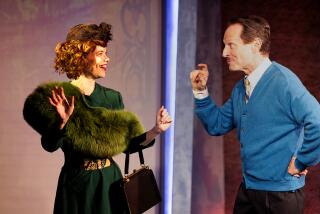An L.A. love letter to Rainer Werner Fassbinder
- Share via
His output was staggering, as were his excesses. And even though he died 30 years ago at age 37, his influence on the next generation of edgy, distinctive filmmakers remains powerful today.
In his brief life, Rainer Werner Fassbinder cut a wide swath through German and international cinema. By the time he died from a combination of sleeping pills and cocaine, Fassbinder had made 40 feature films, two TV series, three short films, four video productions, 24 stage plays and four radio plays. Fassbinder also acted in 36 of his own or other director’s films.
Fassbinder’s films were provocative, erotic, shocking. They were raw, but also lushly romantic. He was influenced by Hollywood, but his films were distinctly German, examining the post-World War II landscape of his devastated homeland. Both as a filmmaker and in real life, Fassbinder was a walking contradiction. Openly gay himself, his films with gay characters, such as 1975’s “Fox and His Friends,” were considered by many to be anti-gay. Though his films criticized violence, he could be violent and cruel in real life.
Starting Thursday, the American Cinematheque and the Goethe-Institut Los Angeles are presenting a two-week retrospective, “Cruelly, Madly, Deeply: The Films of Rainer Werner Fassbinder,” at the Egyptian Theatre in Hollywood and the Aero Theatre in Santa Monica.
“In Germany, there are two postwar directors who are considered really great directors: One is Fassbinder and the other is Konrad Wolf from East Germany,” said the UCLA Film & Television Archive’s director, Jan-Christopher Horak, who has written extensively about German cinema.
Fassbinder helped revive German cinema in the 1970s, and elements of his work can be seen in contemporary directors, from the shockingly iconoclastic films of Denmark’sLars von Trier to the nouveau romantic melodramas of American filmmaker Todd Haynes.
Even fans of his work admit Fassbinder was a nightmare to work with.
“He was totally self-destructive,” said Horak, who spent time in Germany at the height of Fassbinder’s career. “He took drugs like mad. He drank like crazy. He used people. He was violent and he created violence. if he got bored on the set, he would get two of his people to start a fight with each other by making a comment that would start something. That is the kind of person he was. He would slough off old friends just like that.”
Fassbinder’s earliest films were influenced by the raw, experimental style of French New Wave directorJean-Luc Godard. “They seemed improvised and off the cuff because he worked so fast,” noted Horak.
Though his themes never changed — money, sex, society and cruelty — Fassbinder’s style did after he discovered the 1950s melodramas directed by German emigre Douglas Sirk in Hollywood, including 1954’s “Magnificent Obsession” and 1955’s “All That Heaven Allows.”
The festival begins at the Aero with 1974’s “Ali: Fear Eats the Soul,” Fassbinder’s first film made after his own magnificent obsession with Sirk began. The drama is a loose remake of “All That Heaven Allows,” in which a Moroccan guest worker in Germany (played by Fassbinder’s lover El Hadi ben Salem) falls in love with a German woman (Brigitte Mira) 20 years his senior.
Other films in the festival include his first two — the raw, gangster dramas “Love Is Colder Than Death” from 1969 and “The American Soldier” (1970), both of which were inspired by the French New Wave. Beth Hanna, who programmed the series with Grant Moninger and Gwen Deglise, all from the American Cinematheque, said they are hoping the retrospective will attract a “young, artistic-leaning crowd who will get into Fassbinder. I feel like for the most part, he is fairly niche to American audiences.”
Fassbinder, said Horak, was considered a “scandal machine” in the early 1970s. “Every new piece brought a new scandal. There was a huge scandal when he was hired as director of Theater am Turm in Frankfurt, where he lasted for 10 months and was fired with great fanfare for totally destroying the theater. The bourgeoisie press was on his case all the time; but at the same time, the public TV stations were financing all of his films.”
When German filmmakers Fassbinder, Wim Wenders and Werner Herzog burst on the scene in the late 1960s, cinema in their country was in the doldrums. . “The good filmmakers had all left the country or were dead,” said Horak.
Ironically, Fassbinder found himself at odds with his peers after he discovered Sirk in the early 1970s, because he started hiring some of the icons of 1950s cinema to play in his films. “He started working with producers who were more old-line producers, but they didn’t change his character....”
But starting with “The Marriage of Maria Braun,” which was the first of his trilogy set in postwar Germany, and his 15½-hour 1980 miniseries “Berlin Alexanderplatz,” based on the novel by Alfred Döblin, Fassbinder gained respect from both the older and younger generations.
“I was living in Germany when Fassbinder died,” said Horak. “It was a huge thing. There was so much press about it — mostly positive — that Germany’s great filmmaker was gone.”
Classic Hollywood
Want more coverage of vintage movies? Facebook users should like our Classic Hollywood | Los Angeles Times page.
More to Read
The biggest entertainment stories
Get our big stories about Hollywood, film, television, music, arts, culture and more right in your inbox as soon as they publish.
You may occasionally receive promotional content from the Los Angeles Times.











